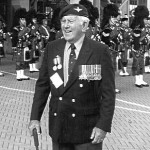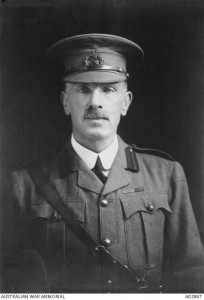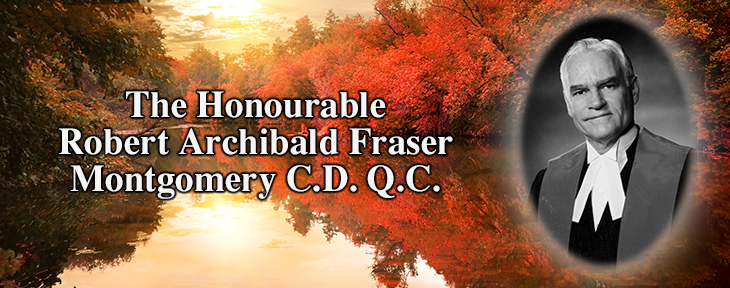
Deaths (2) plus #25 William Throsby Bridges – 100th anniversary
MORE…
RCNC 247 The Honourable Robert Archibald Fraser Montgomery CD QC
It is with profound sadness that the family announces the death of Robert (Bob) Archibald Fraser Montgomery in Calgary on Thursday, April 2, 2015 at the age of 86.
Bob was the dearly loved husband of Margaret (nee Macleod), the proud father of Fraser, Heather and Scott (Sheila), as well as the fun loving and cherished grandpa of Ian, Anna, Andrew, Will, Justin, Stephen and Martin. He will be fondly remembered by his sisters, Patricia and Mitzi, and his sister-in-law, Cynthia Macleod.
Bob was born in Toronto on July 5, 1928, the son of Archibald and Margaret Montgomery. He was educated at St. Andrew’s College, Aurora, ON, Royal Canadian Naval College, H.M.C.S. Royal Roads, Victoria, B.C., Queen’s University, Kingston, ON, and the University of Toronto, Toronto, ON. The practice of law took him to Vancouver, Ottawa, Toronto and Calgary, finally ending his career as a Justice of the Court of Queen’s Bench of Alberta. He served his church, his community, his country and his profession in many different capacities. Through his unceasing love for the Navy he was fondly known to many as the “Commander”.
Bob possessed a strong moral compass and an abiding faith. Everyone with whom he came in contact was accorded the same respect and courtesy. His challenging health never dampened his enthusiasm for life, and he always maintained a brave and courageous spirit. More
***
BILL McALLISTER, former military colleges soccer coach
 McALLISTER, William Andrew Mitchell Sadly on Nov. 2, 2014 William Andrew Mitchell McAllister, 89, passed away with his loving wife, Bernice at his side.
McALLISTER, William Andrew Mitchell Sadly on Nov. 2, 2014 William Andrew Mitchell McAllister, 89, passed away with his loving wife, Bernice at his side.
From Dunoon, Scotland, Bill joined the 1st British Airborne Division at the age of 17. He participated in Operation Market Garden and the Battle of Arnhem – a “Bridge Too Far” Sept. 1944. He was dropped behind enemy lines and would never have survived without the assistance of the Dutch people he was fighting to protect and the evacuation efforts of the 23rd Field Company of the Royal Canadian Engineers. His book “A Time to Remember” has given his family insight into the horrors of war and the immense courage and conviction of those involved.
After the war he immigrated to BC, played professional soccer for Vancouver then Victoria and worked for the Queens Printers.
He rejoined the military and spent many years in Coaching and Physical Education for the Canadian Armed Forces and the three Royal Military Colleges in Canada. He coached the Canadian National Soccer Team in the 1970’s.
After retirement from the military he worked for the B.C. Gov’t in Sports and Recreation before retiring and settling back to Victoria in the late 1980s. In 1991 he was inducted in to the Sports Hall of Fame in Ottawa for his contributions to Boxing and Soccer in Canada. He was an Honorary Member of the Canadian Soccer Association.
He will be sadly missed and fondly remembered by his three daughters, Lynn (Ross), Sharon (CJ) and Sandy (Mike) as well as his grandchildren, Katie, Brianna, Tracy, Amy and Brad. Special thanks to Dr. Moseley and the staff of Lower North at George Derby Center in Burnaby, BC. for keeping him comfortable during his final days. He will rest with his comrades in the Airborne Cemetery in Oosterbeek Holland, a place of peace and tranquility, as he described it.
In lieu of flowers, donations please c/o Mr. G. Melter, First Ontario Credit Union, 486 Upper Sherman Ave., Hamilton, On. L8V 3L8, in Bill’s name, to the Nathan Cirillo Memorial Fund, the soldier who gave his life defending the Veterans Memorial in Ottawa.
***
 #25 William Throsby Bridges, the founder of Duntroon. Monday(18 May) will mark the 100th anniversary of his death following wounds suffered at Gallipoli in 1915.
#25 William Throsby Bridges, the founder of Duntroon. Monday(18 May) will mark the 100th anniversary of his death following wounds suffered at Gallipoli in 1915.
William Throsby Bridges was born at Greenock, Scotland, on 18 February 1861. As a youth he moved to Canada, where he later entered the Royal Military College but failed to graduate. In 1879 Bridges moved to Australia and joined the civil service, working in Braidwood, Murrurundi, and Narrabri. He returned to military life in 1885, taking a permanent commission in the artillery, and that same year married his wife, Edith. For the next few years he held various positions at the School of Gunnery and attended several gunnery courses in England, passing them with distinction. Bridges served with the British army in South Africa from 1899 until he was evacuated with enteric fever in 1900. In January 1909 he became Australia’s first chief of the general staff and the next year was tasked with founding Australia’s first military college, the Royal Military College at Duntroon.
By the time the First World War had broken out Bridges had attained the rank of brigadier general and was given the task of raising an Australian contingent for service in Europe. He was promoted to major general in August 1914 and was appointed the commander of the new Australian Imperial Force. Bridges travelled to Egypt with the first contingent in October and started to record his experiences in a diary from early 1915. From this diary we can observe the evolution of planning for the Gallipoli campaign, including his meetings with commanders like Lieutenant General William Birdwood and General Sir Ian Hamilton and with various Australian commanders who would rise to prominence in the years to come.
Bridges’ division was the first ashore at ANZAC Cove on 25 April 1915 and very soon after he argued for immediate evacuation, owing to what he saw as a hopeless situation. The force stayed and he began paying routine visits to the firing line, showing disregard for his own safety. On 15 May a sniper’s bullet severed his femoral artery and he died three days later on board a hospital ship. He became the only Australian killed in the First World War to have his remains returned to Australia; he was buried at Duntroon.
A few interesting observations about Bridges:
1. He entered RMC as a member of the Second Term that entered on 2 February 1877. However, for reasons that are not clear, Bridges entered later than his fellow recruits, and did not actually arrive at the College until 10 April of that year.
2. Bridges withdrew from RMC Kingston in June 1879 when his family moved to Australia. By virtue of this, he became RMC’s first dropout. (Happens to the best of us !)
3. Bridges was promoted to the rank of Major General in August 1914. As far as we know, he may well have been the very first Ex-Cadet to attain that rank.
4. Because of the timing of Bridges’ death (May 1915) he was undoubtedly one of the first, and very possibly the first, Ex-Cadet to die in combat in the Great War. (Remember that the first time that Canadians saw action was at Ypres in April 1915, less than a month earlier).
5. Bridges was one of 147 Ex-Cadets to die in the Great War. He may very possibly have been the only Ex-Cadet General Officer to die in combat.
6. He was one of only five Ex-Cadets to be appointed as a Knight Commander of the Order of Bath for service during the Great War.
Special thanks to 12570 Mike Kennedy for providing the information on, #25 William Throsby Bridges.


